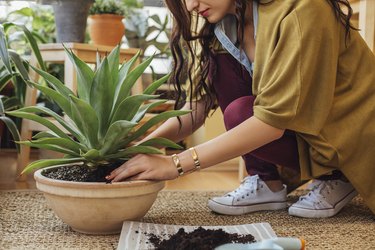
Re-potting a plant is a little like "uprooting" your family to move somewhere else: New surroundings require a bit of an adjustment period. A plant's leaves may show a telltale sign of transplant shock by wilting when you re-pot the plant. Other than this, a plant drooping after repotting may be in response to the soil, amount of water, lighting conditions or even its new pot.
Plant Wilting After Repotting
Video of the Day
In nature, a plant's roots grow in place without being disturbed. When you move a plant from pot to pot, this disturbs its roots. Because the roots are responsible for absorbing water from the soil, any root disturbance can hinder the plant's ability to uptake water, which is why the leaves wilt.
Video of the Day
Handle roots carefully when removing a plant from its pot. If the roots have grown in a circle in the old pot, gently "tease" them apart before placing them into the new container.
Plant Was Over-Watered
Exuberant gardeners may try to get a newly re-potted plant off to a good start by watering it too much, but this can actually "kill it with kindness." Water a re-potted plant sparingly until it establishes roots. If the soil stays so wet that air cannot reach the roots, they may rot or the plant can drown; both conditions can cause leaves to wilt.
Water a plant thoroughly at least an hour before re-potting it so the plant is hydrated when you move it to another container.
Make sure the plant's new pot has a drainage hole so excess water can drain freely.
Plant Was Under-Watered
Some plants, such as peace lily (Spathiphyllum spp.), a perennial in U.S. Department of Agriculture plant hardiness zones 11 through 12, crash if they don't receive enough water, whether they are newly re-potted or established in their containers. Crashing goes beyond the plant drooping after repotting; it means the leaves wilt dramatically, down to the ground.
Revive crashed plants by watering them thoroughly; typically, they rebound in a matter of hours.
Plant Was Fertilized Too Soon

A newly re-potted plant needs an adjustment period before you fertilize it. An immediate jolt of fertilizer adds more stress on top of transplant shock.
Wait two to four weeks before fertilizing a re-potted plant.
New Pot Was Not Sanitized
Many plant pathogens -- the agents that cause disease -- live in the soil. Because these pathogens are microscopic, they can live even in small amounts of soil left in used containers. If you use one of these contaminated containers to re-pot a plant, the plant may become infected with a disease. Plant diseases cause varied symptoms, one of which is wilting leaves.
Sanitize a used pot by soaking it for 10 minutes in a solution that's 1 part bleach and 9 parts water, and scrub the pot with dish detergent and water. For clay pots, you may need to use steel wool or a wire-bristle brush to remove stubborn debris. Follow the sanitizing and cleaning steps by rinsing the pot thoroughly with water.
Potting Mix Was Not Sterilized
The planting medium you use when you re-pot a plant can contain disease pathogens. Purchased potting mixes are typically sterilized, but if you use garden soil to fill a container, it may be contaminated by disease organisms.
To sterilize garden soil:
- Mix equal parts of garden soil and peat moss or vermiculite; if you don't, the soil becomes too hard after it's baked.
- Moisten the soil mixture and spread it in a large baking pan.
- Heat the soil mixture for one hour in a 180- to 200-degree Fahrenheit oven.
- Cool the soil completely before using.
Don't use perlite as a substitute for vermiculite if you heat the soil mixture in an oven. When heated, perlite may release fluoride, which can be toxic to plants.
When a Plant is Unsalvageable

The permanent wilting point for a plant is the point beyond which it cannot be saved. For soft-stemmed, herbaceous plants, crashed plants that cannot be restored to their upright form are past saving.
A simple scratch test can let you know if a woody-stemmed plant needs to be discarded. Scratch the stem of the plant with your fingernail until you remove the top layer, revealing the second layer underneath, called the cambium. If the cambium is green, the plant still has life in it, but if you see a brown or a yellowish color, it does not and you should discard the plant.